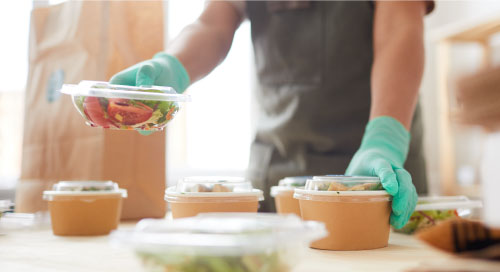CV and AI: The Recipe For Online Food Delivery

Cloud kitchens were born out of the ride-sharing phenomenon of the 2010s, which quickly provided the infrastructure for low-cost food delivery. But while cloud or “ghost” kitchens are like those at most traditional restaurants in terms of function and appearance, that’s about where the similarities end.
As the name implies, cloud kitchens are remote food preparation centers without a traditional dining area. Orders come in over the Internet, food is prepared, and then either picked up by the customer but more often delivered. With the COVID-19 pandemic limiting in-restaurant dining, take-out-only eateries are popping up everywhere.
But while Internet-driven experiences have become commonplace and acceptable in other industries, they can still be disconcerting when it comes to perishable, ready-to-eat food. The real challenge is instilling peace of mind in their customers, and ensuring repeatable, high-quality meal standards. To do so, cloud kitchens and delivery companies like Uber Eats and Takeaway.com are now making the entire process, from prep to delivery, transparent across the web.
Serving Meals With AI Technology
Whereas traditional restaurants use a comparatively “analog” process of passing an order from patron to waiter to cook, there are no waiters in the automated cloud kitchen. The waiter is now an app that links to platforms like the Smart Food QC, from UdyogYantra Technologies, a developer of AI & IoT-based products for food & agriculture.
“The platform helps digitize the food as it moves from raw ingredients to cooking to final food in an assembly line—providing a seamless food experience for customers,” says Ankur Jain, founder and CEO of UdyogYantra. To achieve this, the smart food solution combines order, cooking, inventory, and quality management systems alongside a “food dash” (delivery) system in a modular edge computing platform (Video 1).
Under the hood of the platform, operators will find an API-based platform that supports multiple cameras, thermal imaging devices, a label scanner, and other sensors. The whole system is controlled by an Intel® Celeron® processor, which also executes deep learning computer vision (CV) algorithms developed using the Intel® OpenVINO™ Toolkit.
The CV model consists of three layers, including one that verifies the item is food and a second and third that identify the type of food it is. Thanks to optimizations enabled by the OpenVINO environment, two of the three GPU-intensive layers are executed locally on the edge.
In operation, the Smart Food QC helps standardize and improve the efficiency of meal preparation in several ways. First, the label scanner ensures that only the correct ingredients are used in the appropriate amounts. Then, the cameras and thermal sensors bring an element of quality control, checking things like the weight, temperature, and appearance of a dish before approving it for delivery. Finally, the system applies a QR code to the meal container that is used for tracking during the delivery process.
Once meal prep is complete, open APIs allow the kitchen to expose the collected data to partners and customers via a web interface. This can include information about the chef, meal status, and so on.
The QC solution helps standardize food quality, guarantees that dishes meet sanitation and quality control requirements, and offers customers peace of mind. via @insightdottech
Increase Quality, Lower Costs
The mechanisms described above provide insight into meal preparation that can help standardize food quality, guarantee that dishes meet sanitation and quality control requirements, and offer customers peace of mind. But the benefits of the Smart Food QC can also extend far beyond these parameters to elevate the overall functioning of the entire cloud kitchen.
For instance, by correlating ingredient data captured by the label scanner with the inventory management system, the UdyogYantra system can provide a real-time count of available stock—keeping the kitchen staff aware of what’s on hand at any given moment. The information can also be used to trigger automated actions, such as reordering additional supplies when inventory reaches a predetermined quantity.
And just as important to restaurant management, automating the meal prep process can help reduce costs by minimizing overfilled dishes, food waste in preparation, and customer order rejections.
“Apart from the digital experience, this is where the Smart Food QC actually helps customers save costs and achieve more profitability,” says Jain. “We see a break-even in six months, and in a store doing 300 daily orders, for example, there’s an 8% direct addition to the bottom line.”
Connecting to the Supply Chain
Technology innovations in the cloud kitchen are allowing an unprecedented level of insight into operations—a win-win for consumers and businesses alike. But the potential benefits do not end there. Thanks to standard APIs and the IoT, cloud kitchens can reach far into the connected supply chain to learn about things like food shortages so they can tweak menus well in advance.
Here, where efficiency meets quality, is what the tech-driven culinary experience is all about.